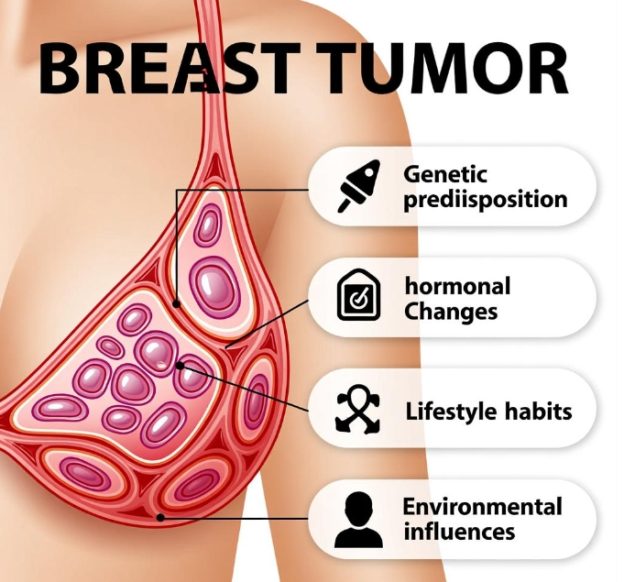Breast tumours comprise a spectrum ranging from benign fibro-epithelial lesions to invasive malignancies. Symptom expression reflects histological subtype, anatomical location, and biological behaviour. Early recognition allows accurate triage between conservative follow-up and definitive oncological therapy.
- Painless palpable mass
Most tumours present as a discrete, firm nodule with variable mobility. Benign lesions (fibroadenoma) are smooth and slippery; malignant masses display irregular, spiculated borders and may fix to pectoral fascia or skin. - Nipple-areolar changes
Recent inversion, persistent eczema-like scaling, or spontaneous serosanguinous/bloody discharge suggests underlying malignancy. Ulceration and malodour indicate locally advanced disease. - Skin alterations
Dimpling along Cooper ligaments, peau d’orange from lymphatic obstruction, and diffuse erythematous induration (inflammatory carcinoma) are pathognomonic for malignancy. Benign tumours do not alter overlying skin. - Axillary and supraclavicular lymphadenopathy
Firm, matted, non-tender nodes ≥1 cm imply regional metastatic spread; fixation to deep structures signals extra-nodal extension. - Cyclical vs. progressive pain
Benign proliferations often produce cyclical mastalgia; persistent, progressive pain without relation to menses raises concern for malignancy or phyllodes tumour. - Multifocality and bilateral disease
Multiple synchronous masses may represent fibroadenomatosis or multifocal carcinoma; contralateral involvement suggests genetic predisposition (e.g., BRCA1/2). - Rapid growth or sudden change
Size increase >20 % within 6 weeks, new skin tethering, or appearance of satellite nodules mandates core biopsy to exclude high-grade malignancy or sarcomatoid transformation. - Systemic and metastatic features
Unintentional weight loss, persistent fatigue, bone pain, pleuritic cough, or neurological deficits indicate advanced malignant disease with distant organ involvement.
| Symptom / Sign | Typical Presentation |
|---|---|
| Palpable mass | Smooth (benign) vs. irregular, fixed (malignant) |
| Nipple changes | Inversion, eczema, bloody discharge |
| Skin signs | Dimpling, peau d’orange, erythema (malignant) |
| Lymph nodes | Firm, matted, ≥1 cm (metastatic) |
| Pain | Cyclical (benign) vs. persistent (malignant) |
| Multifocality | Multiple synchronous or bilateral masses |
| Rapid change | >20 %/6 weeks, tethering, satellites |
| Systemic | Weight loss, bone pain, neurologic deficits |
